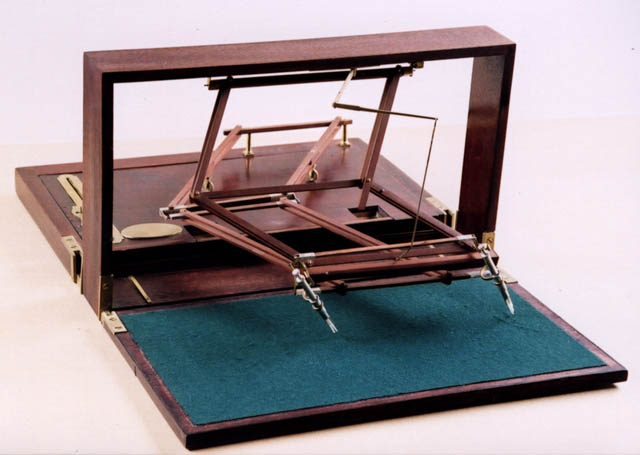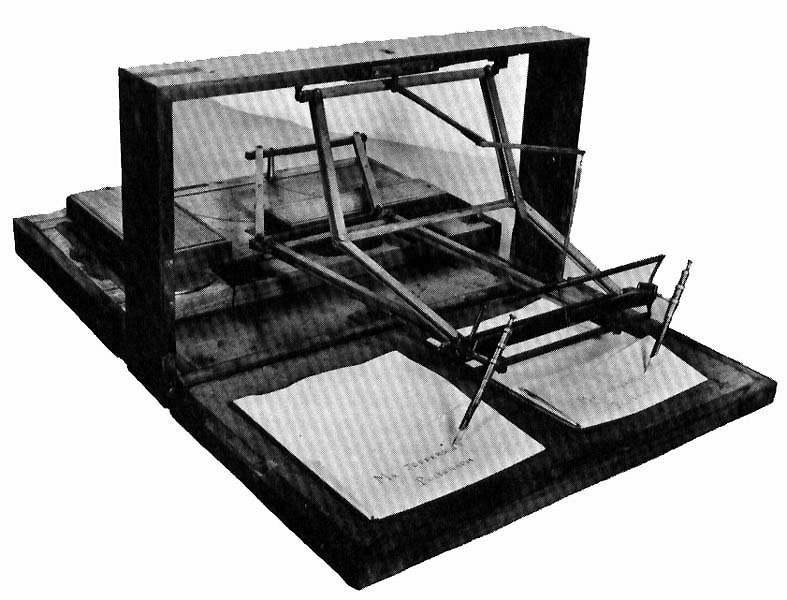polygraph (duplicating device) on:
[Wikipedia]
[Google]
[Amazon]

 A polygraph is a duplicating device that produces a copy of a piece of writing simultaneously with the creation of the original, using pens and ink.
Patented by John Isaac Hawkins on May 17, 1803, it was most famously used by the third U.S. president,
A polygraph is a duplicating device that produces a copy of a piece of writing simultaneously with the creation of the original, using pens and ink.
Patented by John Isaac Hawkins on May 17, 1803, it was most famously used by the third U.S. president,
The Letters of Thomas Jefferson: 1743–1826
(partial index)
Including quotations from Jefferson about the polygraph and the connection between Jefferson's philosophies and the technologies he employed (Texas Tech University, Department of English)
''A Modern Monticello''
''Do we really need interactive exhibits to bring Jefferson to life? Yes, we do.'' By Anne Applebaum (Slate.MSN.com)
Portable version of the Polygraph
Image at Make.com
''Monticello's Makeover''
Describes public hands-on access to a replica Polygraph. Technical drawing tools Printing

 A polygraph is a duplicating device that produces a copy of a piece of writing simultaneously with the creation of the original, using pens and ink.
Patented by John Isaac Hawkins on May 17, 1803, it was most famously used by the third U.S. president,
A polygraph is a duplicating device that produces a copy of a piece of writing simultaneously with the creation of the original, using pens and ink.
Patented by John Isaac Hawkins on May 17, 1803, it was most famously used by the third U.S. president, Thomas Jefferson
Thomas Jefferson (, 1743July 4, 1826) was an American Founding Fathers of the United States, Founding Father and the third president of the United States from 1801 to 1809. He was the primary author of the United States Declaration of Indepe ...
, who acquired his first polygraph in 1804 and later suggested improvements to Charles Willson Peale
Charles Willson Peale (April 15, 1741 – February 22, 1827) was an American painter, military officer, scientist, and naturalist.
In 1775, inspired by the American Revolution, Peale moved from his native Maryland to Philadelphia, where he set ...
, owner of the American rights. . Because Jefferson was a prolific letter writer, the preservation of his copies have offered historians extensive insights into Jefferson's viewpoints and actions.
Jefferson called the polygraph "the finest invention of the present age".
Another American, Benjamin Henry Latrobe
Benjamin Henry Boneval Latrobe (May 1, 1764 – September 3, 1820) was a British-American Neoclassical architecture, neoclassical architect who immigrated to the United States. He was one of the first formally trained, professional architects in ...
, was the first customer of Peale's and not only introduced the device to Jefferson but was also instrumental in its improvement.Bedini, Silvio A. (1984). ''Thomas Jefferson and His Copying Machines''. Charlottesville: University Press of Virginia. . pp. 53 ff.
Mechanisms of this type are more generally known as pantograph
A pantograph (, from their original use for copying writing) is a Linkage (mechanical), mechanical linkage connected in a manner based on parallelograms so that the movement of one pen, in tracing an image, produces identical movements in a se ...
s, which include simple devices for making copies at various enlargements or reductions by tracing over a drawing.
Description of the device
Stationary parts
Platform
The platform forms both a writing surface (in part) and a base and reference plane for the moving and other stationary parts ("F" in diagram). In a portable device the platform is in two parts that form the covers of the enclosure formed for transport. As suggested by Jefferson, a non-portable version uses a single board for the entire platform.Bridge
Also known as a "gallows frame", the bridge spans the platform ("A" and "B" in diagram). In the non-portable device this is mounted on posts permanently attached to the platform. In the portable version the bridge, side posts, and a bottom cross piece form the outer rim of enclosure when in the state for transportation. The bridge divides the platform into two portions, the part toward the user upon which the papers are placed (see illustration above), and the stationary part away from the user that contains a portion of the planar pantograph. The function of the bridge is to form a base for the vertical movement linkage and a support for the suspension spring support beam.Inkwells
Inkwells are provided beneath the bridge for each pen at corresponding locations. The dipping of the master pen will thus re-ink the slave pen.Moving parts
The device consists of two pens transmitting motion in fivedegrees of freedom
In many scientific fields, the degrees of freedom of a system is the number of parameters of the system that may vary independently. For example, a point in the plane has two degrees of freedom for translation: its two coordinates; a non-infinite ...
through four interlinked mechanisms:
#A horizontal pantograph maintains identical planar (X and Y axis) movement, with two degrees of freedom
#An angled pantograph descending from the bridge maintains identical vertical (Z axis) movement
#A torsion beam maintains identical pen fore-and-aft tilt
#A parallel linkage maintains identical pen side-to-side tilt
In addition, a vertical suspension spring balances the weight of the moving parts.
Planar pantograph
The range of the planar mechanism must be sufficient to encompass the papers (individually) being written upon and allow access for each pen to its respective inkwell. A simple pantograph is used to translate the planar motion of one pen to the other. The pantograph consists of two complete variableparallelogram
In Euclidean geometry, a parallelogram is a simple polygon, simple (non-list of self-intersecting polygons, self-intersecting) quadrilateral with two pairs of Parallel (geometry), parallel sides. The opposite or facing sides of a parallelogram a ...
s ("d" and "e" in diagram):
*Base parallelogram: The base parallelogram is attached to two fixed pivot points at the far side of the base plate. The pivoting arms are supported at their midpoints by wheels which rest on the base and this part remains in a plane parallel to the base.
*Extension parallelogram: The extension parallelogram is attached to the base parallelogram by pivots that allow the pen-side edge to be lifted away from the base.
Descending pantograph
A second pair of parallelogram links maintains vertical correspondence between the two pens ("D" and "E" in diagram). These consist of two variable parallelogram frames attached at a common edge, one of which is also attached to the bridge, while the other is attached to one of the pen supports at each corner. The projecting sides of the upper frame consist of parallel linkages.Pen lift transfer
The combination of forces between the horizontal and vertical enables the pen lift of the principal pen grasped by the user from the paper to be transferred to the copying pen. *Pen mounts: Each pen is mounted in such a way that it allows the pen to be used at various angles, necessary to allow a normal writing style. The pens are offset from their pivots by a short stem that projects at right angles from below the midpoint of the pen, allowing the pen to be grasped in whatever way is usual to the user ("a" in diagram). *Pen tilt (fore and aft): A torsion beam joins the pen mounts to maintain correspondence of tilt with respect to the direction away from the user ("G" in diagram). *Pen tilt (side-to-side): A parallel linkage maintains correspondence of tilt with respect to a direction parallel to the front face of the device ("H" in diagram). *Suspension beam and spring: At the center of the bridge a beam projects horizontally toward the user ("K" in diagram), from which a vertical suspension spring ("I" in diagram) balances most of the weight of the moving parts so that the user is neither fatigued by using the device nor is required to adjust their writing style.Viewing in museums
Original polygraphs may be viewed at a number of locations around the world. Some United States locations: *Monticello
Monticello ( ) was the primary residence and plantation of Thomas Jefferson, a Founding Father, author of the Declaration of Independence, and the third president of the United States. Jefferson began designing Monticello after inheriting l ...
, Jefferson's estate in Virginia
*Smithsonian National Museum of American History
The National Museum of American History: Kenneth E. Behring Center is a historical museum in Washington, D.C. It collects, preserves, and displays the heritage of the United States in the areas of social, political, cultural, scientific, and m ...
, Washington, D.C.
Patent
The original American patent document for the polygraph, issued to John J. Hawkins on May 17, 1803, was lost in a Patent Office fire in 1836.A modern version
The Griffin Discovery Room at Monticello contains a simplified and durable version, intended for use by children.See also
*Autopen
An autopen, or signing machine, is a device used for the automatic signing of a signature. Prominent individuals may be asked to provide their signatures many times a day, such as celebrities receiving requests for autographs, or politicians s ...
, another signature duplicating device
* LongPen, a remote signing device conceived by writer Margaret Atwood
*Telautograph
The telautograph is an ancestor of the modern fax machine. It transmits electrical signals representing the position of a pen or tracer at the sending station to repeating mechanisms attached to a pen at the receiving station, thus reproducing at ...
, another remote signing device, patented by Elisha Gray in 1888
References
Further reading
* Bedini, Silvio A. (1984). ''Thomas Jefferson and His Copying Machines''. Charlottesville: University Press of Virginia. {{ISBN, 978-0-8139-1025-3External links
The Letters of Thomas Jefferson: 1743–1826
(partial index)
Including quotations from Jefferson about the polygraph and the connection between Jefferson's philosophies and the technologies he employed (Texas Tech University, Department of English)
''A Modern Monticello''
''Do we really need interactive exhibits to bring Jefferson to life? Yes, we do.'' By Anne Applebaum (Slate.MSN.com)
Portable version of the Polygraph
Image at Make.com
''Monticello's Makeover''
Describes public hands-on access to a replica Polygraph. Technical drawing tools Printing